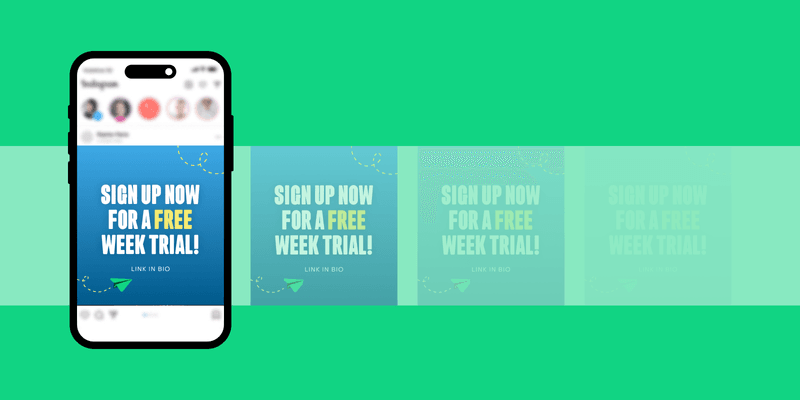Key summary: Ad fatigue occurs when advertising algorithms allocate the majority of spend to a small number of top-performing creatives, leading to rising costs and declining engagement over time. To counter this, marketers should regularly introduce new creatives, apply bid or cost caps, refresh ad copies, and adjust campaign goals when necessary. These strategies help maintain campaign efficiency and reduce dependency on a limited set of assets.
The old way of marketing — when you had to be very precise with audience settings — is gone. Now, algorithms are smarter than ever. They have more data points than we do, so they know better who the best user is for each type of ad.
These data points include a wide range of different behaviors: clicks, likes, comments, shares, saves, views, average time of view, CTR, conversion rates, etc. Ad networks are increasingly focused on gathering this data with the highest accuracy possible because they know it’s key to effective targeting in an era of continuous constraints due to data privacy.
Because of this large amount of data, algorithms are faster than ever at picking the best creatives within your ad groups and shifting most of the budget towards them. In this context, having a good amount of winning creatives is key to preventing algorithms from sending all the traffic to a single winning creative (the one they consider best for the optimization goal selected by the advertiser).
Otherwise, you can find a situation as shown in the following screenshot from Meta Ads:

In today’s article, we’ll analyze the side effects of this type of situation with your paid campaigns and also explore different strategies to avoid it.
Why does it happen?
Although it depends on the type of campaign (CPI, CPA, ROAS), algorithms typically optimize towards upper-funnel metrics because they believe that by lowering the cost at the upper funnel, they can also lower the cost of the down-funnel events we may choose.
This type of optimization performed by ad networks causes algorithms to face the following consequences:
- The videos and banners you use will receive spend depending on engagement, which can lead to a possible dis-correlation between cost per install and audience quality.
- Algorithms tend to shift 90% or more of the budget towards just 2–3 creatives, all based on upper-funnel metrics as mentioned above.
- These 2–3 top creatives set your baseline of quality. If you can’t produce more creatives that eventually outperform this baseline, the algorithm will keep spending on the same creatives over time.
- If you can’t refresh the campaign with new, high-performing creatives and continue relying on the same assets, you’ll likely face the infamous “ad fatigue”—when your top assets start to show higher frequency and a gradual loss of efficiency, leading to declining CTR and rising costs (in both lower and upper funnel metrics).
How to deal with it
As you can imagine, pausing the top-winning creatives to force algorithms to spend on new or underperforming creatives does not work (unfortunately, it’s not that easy).
This usually results in much worse performance, as you’re forcing algorithms to spend on creatives that are considered below your campaign’s baseline. This eventually leads to higher cost per action—sometimes even higher than the potential cost you might incur if the top assets experience ad fatigue.
With that in mind, it’s essential to highlight that sooner or later, you will need new creatives. Although you might try some of the strategies below, the best way to maintain good performance without ad fatigue is to rotate ad groups with new assets continuously (I recommend at least once a week). This approach can help you eventually find other outperforming creatives that reduce your dependency on the initial ones that gathered most of the spend and impressions.
Now, let’s look at your options when, for some reason, you don’t have resources to produce new assets quickly and you start to face ad fatigue:
1. Pausing for 5–7 days and then reactivating
As mentioned earlier, algorithms typically distribute spend between 2–3 creatives. One strategy to “recover” efficiency is to pause one of these top-performing assets and allow the others (1 or 2) to receive all the spend for a week. After that, you can pause the other two to “reset” the overall performance gradually.
In my experience, this strategy can work for up to 2 weeks. After resetting the assets once, the effect is gone, and to achieve another reset, you’ll need to wait at least a couple of weeks for the assets to perform well again.
2. Introducing bid caps
Another strategy that can limit ad fatigue if you can’t rotate assets is to apply bid or cost caps on your ad groups (although the availability of these caps depends on the ad network you use). This lets you limit how much you spend per action according to the campaign’s goal.
Although this strategy can mitigate or delay the negative effects of ad fatigue, if you don’t rotate creatives, the algorithm will eventually spend less and less. This will cause your campaigns to generate fewer signals, leading to worse performance over time. This strategy is only suitable for short-term use.
3. Refreshing copies
Most ad networks require advertisers to use ad copies alongside videos or banners. Rotating these copies can delay ad fatigue because the algorithm needs to re-test the same creative with different text.
However, given the relatively low weight of copies in overall performance, I personally find this strategy less effective, as the algorithm quickly recognizes the same level of performance as before.
4. Changing the campaign goal
I only recommend this strategy when you don’t have any other options. Normally, we focus on optimizing campaigns towards the most important action. But if you’re seeing ad fatigue and rising costs across every funnel stage, you can switch to a different event (immediately upper or lower to your primary action) to start a new campaign from scratch.
This will start a new learning phase with a different optimization goal. However, the same creatives (or even fewer) will likely get most of the spend, leading to a similar situation. At least this can delay or mitigate the negative effects of dependency.
If you switch to an event immediately after your primary action, make sure to allocate enough daily budget to exit the learning phase. Otherwise, you’ll get a “learning limited” status, and campaign performance could worsen—ad fatigue effects included.
Changing the goal isn’t ideal, as the audiences you reach may differ from the BAU goal, potentially leading to worse conversion rates and ROAS.
What’s the best case scenario?
When you have resources to produce new assets consistently, the fastest way to find other outperforming creatives is through a simple setup: one campaign per country with two ad groups:
- One BAU ad group with 70–80% of the budget using your winning assets.
- One testing ad group with 20–30% of the budget (depending on resources and how fast you want to test), adding 2–3 new creatives every 2–3 days, depending on impressions, installs, and event signals.
This setup helps your testing ad group nurture the BAU ad group with new winning creatives that compete with each other, causing spend to be more distributed and performance to suffer less when ad fatigue starts affecting your winning assets.
It’s essential to highlight that campaigns should always be optimized towards your most important action. Remember the first paragraph: targeting is done through creatives. If you create this setup but optimize for a different event, you may notice changes in behavior between creatives, which could lead to incorrect decisions about which creatives are best for your campaigns.
This approach helps you build a system where your testing ad group provides clear evidence of what elements you need to focus on to build great creatives—hooks, music, headlines, transitions, features, messaging, creators, etc.
In my experience, the best way to get this data is by analyzing the following KPIs:
- CPA
- CPI
- CTR
- Install Rate
- Hook Rate
- Hold Rate
- Engagement Rate
- IPM
- Conversion Rate from Install to Action
- Frequency
- Average Watch Time
Analyze these KPIs from your testing assets and compare them to your BAU creatives. You’ll see why your top-performing assets gather most of the spend and what you need to achieve to outperform them. In other words, you’ll discover your baseline and the quality level needed to nurture your BAU ad group, so you can keep your campaigns fresh while scaling.
Conclusion
Having a decent volume of creatives is key to keeping your campaigns performing well over time. In some situations, there are tricks you can use to delay the negative effects of relying on just one or two creatives.
However, we’re seeing how companies are increasingly focused on creating content, and even major players are ramping up their variations year over year when it comes to paid ads.
I hope this article helps you manage your campaigns effectively in any situation and understand why your top creatives always gather most of the spend.
Key takeaways:
- Algorithms optimize spend based on engagement, favoring a few creatives over time.
- Without new creatives, campaigns face ad fatigue: rising costs and declining CTR.
- Rotating ad assets weekly, refreshing copies, and testing new concepts can help.
- Applying bid caps and adjusting goals may temporarily mitigate ad fatigue.
- Continuous testing and analysis of key KPIs are essential for sustained growth.

